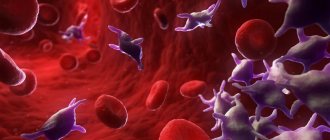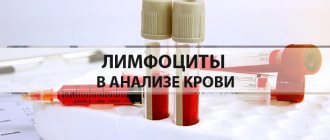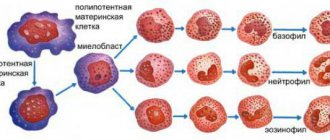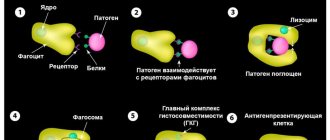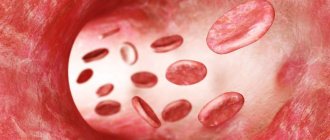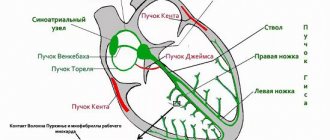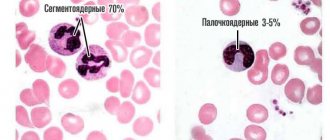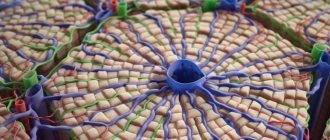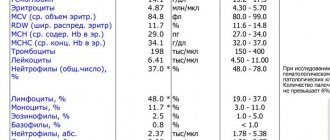A blood test is the most common and accessible method for general health assessment. Changes in the composition of the blood determine the development of pathology. During the study, such an indicator as the level of neutrophil granulocytes is of great importance. These cells are the largest group of leukocytes that perform an important protective function.
If neutrophils are elevated, most often this means that an inflammatory process is occurring in the body. This condition is called “neutrophilosis”. It should be said that in an adult healthy person, mature cells (segmented cells) predominate in the bloodstream. Their maturation occurs in the bone marrow, after which they enter the blood. If an infectious agent has entered the body or inflammation has developed, then young forms begin to quickly be released from the brain, which include myeloblasts, promyelocytes, metamyelocytes and band cells. As a rule, with an increased content of neutrophil granulocytes, immature cells are found in the blood. In this case, they say that there has been a shift in the leukocyte formula to the left.
An increase in neutrophils in the blood is called neutrophelosis
Normal in blood
Neutrophils are the most numerous cells of all types of leukocytes: their share is from 50% to 70% of all white blood cells.
If you look at the test form, you can see their different designations due to the fact that when counting, neutrophils are divided into band (not fully mature) and segmented (fully mature). The norm of segmented leukocytes in the blood of women is the same as that of men, and is 1500 – 8000 units/mm3. The determination of low segmented neutrophils in the blood of a child differs from the norm in an adult. The lower norm for children aged 2 weeks to 1 year is 1000 units/mm3. But after a year, this norm becomes like that of an adult.
It should be noted that the count of leukocytes strongly depends on the type of equipment (ie hematology automatic analyzers) on which the count is carried out. Therefore, segmented neutrophils, the norm of which is measured on different equipment and in different laboratories, should always be compared only with those values that are printed on tests in the laboratory.
Structure
Leukocytes are divided according to their structure into granulocytes, which have pinpoint granules in the plasma, and agranulocytes, without additional inclusions. Unlike red blood cells and platelets, these cells are endowed with a nucleus and are able to exit blood vessels and move towards inflamed tissues.
There are two neutrophils in the center, their nuclei are divided into parts (segments)
Granulocytes differ in relation to staining using the Romanowsky method for basophils, eosinophils and neutrophils.
The group of neutrophils is also not homogeneous: according to the shape of the nucleus, they are divided into segmented (the nucleus is divided into parts by constrictions) and rod-nuclear (the nucleus has the shape of an elongated ball).
In the normal blood composition of an adult, the level of segmented neutrophils is 47–75%, and band neutrophils are only 1–6%. “Rods” are considered the precursors of nuclear division; their small number is normally explained by the rapid process of transformation into a segmental, more mature form.
If you are interested in the norms of this indicator in children and the reasons for their deviation, we recommend reading this article.
Segmented neutrophils are increased
If neutrophils in the blood are elevated, what does this mean and what is the reason – doctors cannot immediately answer for sure. The only correct statement is the presence of an infection, a pathology complicated by the penetration of pathogenic microbes into the body. In order to accurately establish a reliable cause, a thorough, comprehensive examination of the entire body is required.
However, in most cases, increased segmented neutrophils in the blood are recorded when:
- development of bacterial infection;
- the appearance of a fungal infection;
- mild inflammatory process.
Segmented neutrophils are increased - reasons
An increase in segmented neutrophils is always a reason to examine the body. In such cases, they speak of a shift in the leukocyte formula to the right.
Among the common situations accompanied by this symptomatology, it is necessary to highlight:
- Not related to pathology: physical activity, food intake.
- Pathological: purulent abscesses, burns, trophic ulcers, leukemia, acute inflammatory diseases (pneumonia, tonsillitis, otitis, sepsis, peritonitis), the formation of malignant or benign tumors.
Segmented neutrophils are increased - what to do?
The main task in this case is to determine the reason why increased segmented neutrophils are detected.
The patient is indicated for additional examination, including consultations with the following specialists:
- therapist;
- infectious disease specialist;
- hematologist.
The patient must strictly follow the doctor's instructions and prescriptions. If neutrophilia is caused by a certain pathology, therapy is aimed at its complete cure.
- Reduced neutrophils in the blood
To help your body recover faster, doctors recommend following the following rules:
- Rejection of bad habits.
- Healthy eating.
- Seasonal therapy using multivitamins.
Reasons for the increase
If a blood test shows that the level of neutrophils is higher than normal, this means that there is inflammation in the body. This is especially true for purulent processes. The causes of this condition are numerous, including the following diseases:
- Hemolytic anemia, which can occur as a result of significant blood loss.
- Infections of bacterial origin: pneumonia, tonsillitis, scarlet fever, phlegmon, abscesses, osteomyelitis, purulent meningitis, salpingitis, acute cholecystitis, purulent pleurisy, thrombophlebitis, peritonitis, appendicitis, otitis and others).
- Inflammatory processes: rheumatoid arthritis, rheumatism.
- Heart attacks (lung, myocardium, brain).
- Skin diseases (dermatitis, psoriasis and others).
- The burns are extensive.
- Severe renal failure.
- Sepsis.
- Trophic ulcers.
- Gangrene.
- Osteomyelofibrosis, leukemia, erythremia.
- Taking certain medications (adrenocorticotropic hormone, glucocorticosteroids and others).
- Disintegration of tumors.
- Poisoning with insect venom, turpentine, carbon dioxide, lithium preparations, heparin, casein.
- Diabetic coma.
- Allergic reactions.
- Parasitic diseases.
The level of neutrophils increases in acute infectious diseases such as tonsillitis, otitis media, pneumonia, etc.
The most pronounced neutrophilia and a shift of the leukogram to the left can be observed during purulent processes, such as abscess, phlegmon, etc.
Neutrophilia is observed less frequently with trophic ulcers, strokes, heart attacks, lymphomas, burns, and taking medications (glucocorticoids). You can read about the causes of low neutrophil counts in adults here.
If segmented neutrophils are increased
The growth of cells of the neutrophil species is called neutrophilosis. The level of segmented neutrophils exceeds 75%.
Both segmented and rod cells increase.
Sometimes earlier forms appear in a blood test - myelocytes, but segmented ones do not change. In the leukocyte formula, this looks like a shift to the left (according to the location of cells in the list of leukocyte forms). At the same time, granularity is detected in neutrophils.
The causes of neutrophilia can be:
- infection with acute bacterial, fungal infection, spirochetes;
- exacerbation of the inflammatory process in rheumatism, pancreatitis, polyarthritis;
- the presence of a dead area in the body, for example, in acute myocardial infarction;
- recent vaccination;
- severe alcohol intoxication;
- disintegrating tumor;
- damage to the kidney tissue, especially with diabetic nephropathy;
- treatment with steroid hormones, heparin.
Vaccination of the adult population is carried out according to epidemic indications.
A shift to the right is detected when a high level of segmented forms predominates over younger band forms. It's possible:
- Segmented neutrophils are increased in the child’s blood and nasal smear. Reasons what to do
- after acute blood loss;
- as a reaction to blood transfusion;
- for some types of anemia.
The cause of a temporary increase in neutrophils may be:
- condition before menstruation in women;
- long-term stress associated with increased workload;
- physical stress.
Pregnancy causes a general increase in white blood cells by 20%. This is the protection of the mother and fetus from unwanted influences. During pregnancy, the absolute number of segmented neutrophils is increased (more than 6 x 109/l), and their relative level in the formula remains unchanged.
To determine the severity of the disease, neutrophilia is divided into forms:
- moderate - the number of cells is not higher than 10 x 109/l;
- pronounced - absolute content from 10 to 20 x 109/l;
- severe - cell count above 20 x 109/l.
Pelger's anomaly of neutrophils
Pelger's anomaly refers to a hereditary morphological change in the structure of neutrophil cells, namely, in the process of segmentation of their nucleus.
The disease has no clinical manifestations and is detected accidentally during a general blood test with a leukocyte count.
Due to segmentation anomalies, old segmented neutrophils in the analysis look like young band neutrophils. That is, such neutrophils have one unsegmented nucleus.
Pelger's anomaly does not lead to changes in cell granularity and does not impair their functionality. Neutrophils with pelgerized nuclei are not defective and are able to adequately perform their functions.
However, such cells often cause misinterpretation of the CBC due to the presence of a false left shift.
To confirm the Pelger anomaly, it is necessary to examine the blood of the parents (since the pathology is hereditary). In the future, before taking tests, it is necessary to notify the doctor and laboratory staff about the presence of this anomaly.
For reference. Patients with pelgerized neutrophils also do not require special treatment.
Normal indicators
There is a leukocyte formula that allows you to assess the condition of the blood and the body as a whole.
The table shows the indicators of a healthy person:
| Index | Normal values |
| % | x10 9 /l | |
| Band neutrophils | 42887 | 0,04-0,3 |
| Segmented neutrophils | 45-72 | 2-5,5 |
| Eosinophils | 0,5-5 | 0,02-0,3 |
| Basophils | 0-1 | 0-0,065 |
| Monocytes | 43042 | 0,09-0,6 |
| Lymphocytes | 19-37 | 1,2-3 |
What are segmented neutrophils responsible for? For the immune response during a bacterial infection.
Of the total number of neutrophils in the blood, 45-72% are cells with segments in the nucleus. This is an indicator of the norm.
It varies depending on several factors:
- Segmented neutrophils are reduced
- The age of the person. In newborns, the indicator may be at its maximum level. During the first month of life, a decrease occurs down to a minimum percentage of immature cells. When a child reaches 6-7 years of age, the number of segmented neutrophils stabilizes. The immune system is strengthened. After 7 years, the norm of mature elements in a child coincides with the indicators of an adult.
- Absolute indicator. In some cases, a value is taken into account, which is calculated by the number of mature cells per microliter of blood. The norm for an adult is 1800-6500 neutrophils.
- Temporary factors. Mostly, deviations occur in children. A decrease and increase occurs after vaccination, during teething.
In other cases, deviations from the norm are a sign of an inflammatory process.
Classification
The cells are produced in the bone marrow.
Depending on their maturity, neutrophils are divided into 6 groups:
- Myeloblasts. It is formed from stem cells in the bone marrow. This cell is the basic one. Subsequently, it is transformed and modified.
- Promyelocytes. The cell is of considerable size and round in shape. The key to the structure of promyelocytes is the nucleus, which fills almost the entire volume of the cell.
- Myelocytes. The element decreases in size and acquires the correct shape. The color of the kernel is bright purple.
- Metamyelocytes. They are small in size and round in shape. The core resembles the outline of a horseshoe.
- Band neutrophils. The main part of the cell is occupied by the cytoplasm - semi-liquid content. The core narrows.
- Segmented neutrophils. The cell differs from the rod cell in the structure of the nucleus, which is divided into segments. A segment is a part in the form of a lobule. Other characteristics: size, cytoplasmic volume, granular structure do not change. A segmented neutrophil is a mature cell. The remaining groups are immature elements and are much smaller in number.
Neutrophils - what are they?
Neutrophils play a very important role in human immunity, removing and destroying microorganisms, unnecessary metabolic products, foreign substances, damaged and malfunctioning cells. Neutrophils perform these functions by the method of phagocytosis, that is, by the method of absorbing and eating these substances.
Neutrophils also participate in a very necessary process for the body called proteolysis, which breaks down proteins into their component parts . This is done by adding water to protein molecules. It is worth noting that proteins are very complex substances that consist mainly of amino acids necessary for the renewal and functioning of the human body.
Neutrophils are produced primarily in the bone marrow, which fills cavities in the bones. Once the white blood cells are sufficiently formed, they leave the bone tissue and travel through the blood circulation. Here they are usually divided into two types - segmented and band leukocytes. When they say that a neutrophil is mature, this means that its development has reached its greatest point. This cell goes through several stages in its development:
What does a general blood test show during pregnancy? 34528
- Myeloblast.
- Promyelocyte.
- Myelocyte.
- Metamyelocyte.
- Band forms.
- Segmented, mature form.
The main characteristic of a mature neutrophil is that its nucleus (central structure) is divided into 3-5 sections called nuclei, which do not exist separately, but are connected together by thin threads called chromatin. Under the magnification of a strong microscope, these nuclei are clearly visible.
Functions
Band and segmented neutrophils protect the body from infections, primarily bacterial and fungal. They are able to migrate outside the bloodstream to the source of inflammation, absorb microorganisms, and destroy them with the help of enzymes.
This ability of leukocytes is called phagocytosis, which happens:
- completed;
- unfinished.
When phagocytosis is completed, the microbe is completely digested inside the neutrophil, and its remains are thrown out of the cell. If not completed, the leukocyte dies along with fragments of microorganisms and is excreted in the form of purulent discharge. One segmented neutrophil can digest up to 30 bacteria.
- Band neutrophils: normal in the blood, reasons for increase and decrease
The membranes of segmented neutrophils can easily change their shape, forming protrusions, with the help of which the leukocyte moves to the site of introduction of the microorganism. The neutrophil chooses the direction of movement based on chemicals released by damaged tissues. This method of movement is called chemotaxis.
In addition to phagocytosis, segmented granulocytes perform the following functions:
- bactericidal - release substances that kill bacteria;
- influence the blood coagulation system;
- affect body temperature;
- play an important role in regulating the intensity of inflammation and activation of the immune system.
What does a segmented neutrophil look like?
Consequences of deviation of neutrophils from the norm
A change in the level of neutrophils in the blood is a signal from the body about the presence of inflammatory diseases, injuries or poisoning. Therefore, it is necessary to accurately determine the cause of the increase or decrease in neutrophils in order to begin treatment in time or eliminate the provoking factor. If this is not done on time, the consequences can be severe (even death). The greatest danger among possible causes is infectious diseases of a bacterial nature, as well as processes of local suppuration and necrotization (death) of tissue.
How to maintain normal neutrophil levels
To have normal levels of segmented neutrophils, you should take care to support your immunity and not waste it. Particular importance should be given to a woman’s environment during pregnancy.
- Vitamins from fruits and vegetables have a positive effect; food should be moderately high in calories and varied.
- According to indications, you should get vaccinated against influenza and other diseases, without waiting for the beginning of the period of increased incidence.
- To the usual hygiene rules of washing hands with soap, you should add rinsing your nose with clean water. Cleansing the mucous membrane and villi improves their protective function.
Hardening procedures can relieve the body of many problems.


